2014 FORD F SERIES MOTORHOME AND COMMERCIAL CHASSIS climate control
[x] Cancel search: climate controlPage 24 of 143
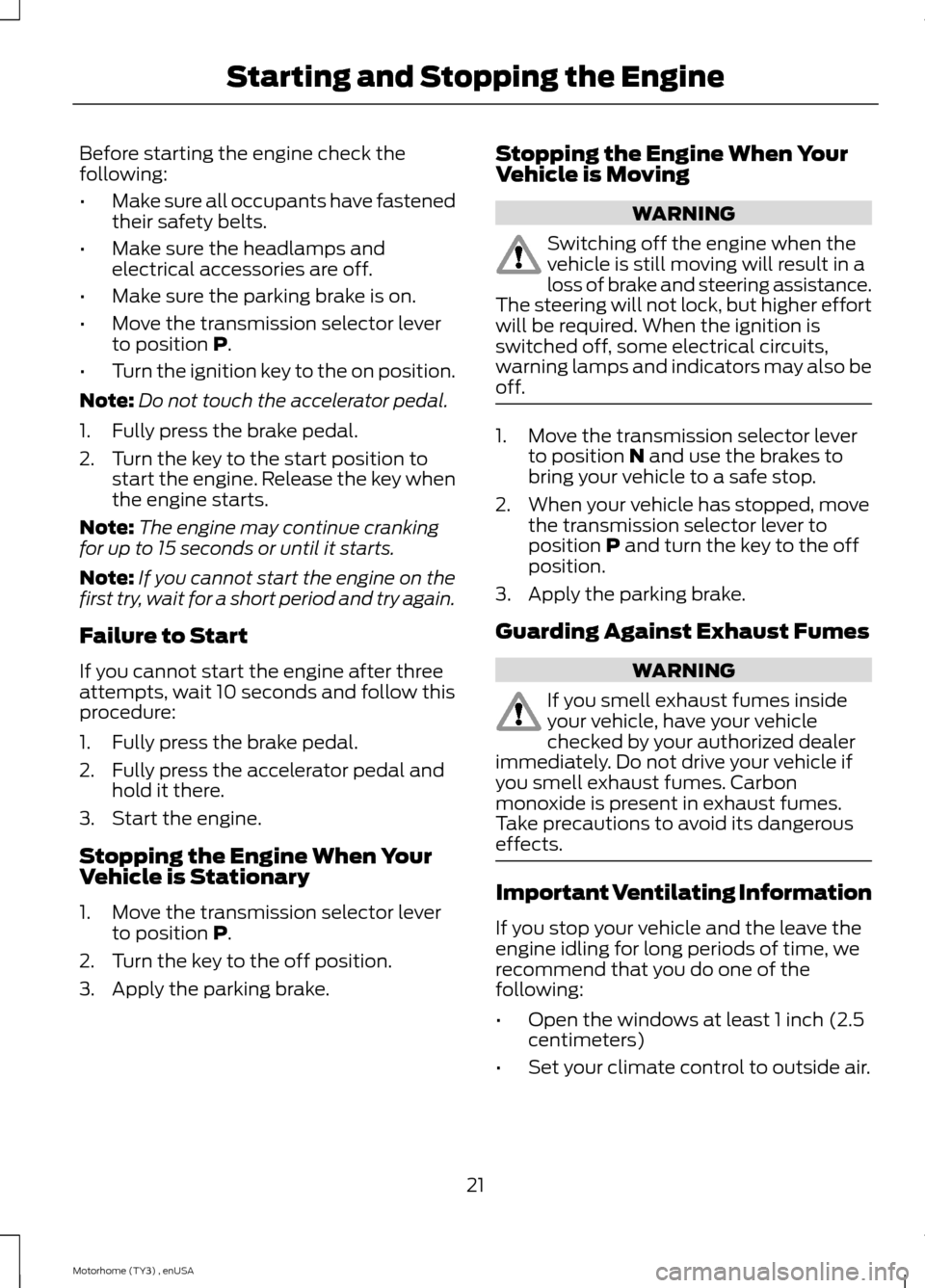
Before starting the engine check thefollowing:
•Make sure all occupants have fastenedtheir safety belts.
•Make sure the headlamps andelectrical accessories are off.
•Make sure the parking brake is on.
•Move the transmission selector leverto position P.
•Turn the ignition key to the on position.
Note:Do not touch the accelerator pedal.
1.Fully press the brake pedal.
2.Turn the key to the start position tostart the engine. Release the key whenthe engine starts.
Note:The engine may continue crankingfor up to 15 seconds or until it starts.
Note:If you cannot start the engine on thefirst try, wait for a short period and try again.
Failure to Start
If you cannot start the engine after threeattempts, wait 10 seconds and follow thisprocedure:
1.Fully press the brake pedal.
2.Fully press the accelerator pedal andhold it there.
3.Start the engine.
Stopping the Engine When YourVehicle is Stationary
1.Move the transmission selector leverto position P.
2.Turn the key to the off position.
3.Apply the parking brake.
Stopping the Engine When YourVehicle is Moving
WARNING
Switching off the engine when thevehicle is still moving will result in aloss of brake and steering assistance.The steering will not lock, but higher effortwill be required. When the ignition isswitched off, some electrical circuits,warning lamps and indicators may also beoff.
1.Move the transmission selector leverto position N and use the brakes tobring your vehicle to a safe stop.
2.When your vehicle has stopped, movethe transmission selector lever toposition P and turn the key to the offposition.
3.Apply the parking brake.
Guarding Against Exhaust Fumes
WARNING
If you smell exhaust fumes insideyour vehicle, have your vehiclechecked by your authorized dealerimmediately. Do not drive your vehicle ifyou smell exhaust fumes. Carbonmonoxide is present in exhaust fumes.Take precautions to avoid its dangerouseffects.
Important Ventilating Information
If you stop your vehicle and the leave theengine idling for long periods of time, werecommend that you do one of thefollowing:
•Open the windows at least 1 inch (2.5centimeters)
•Set your climate control to outside air.
21Motorhome (TY3) , enUSAStarting and Stopping the Engine
Page 92 of 143
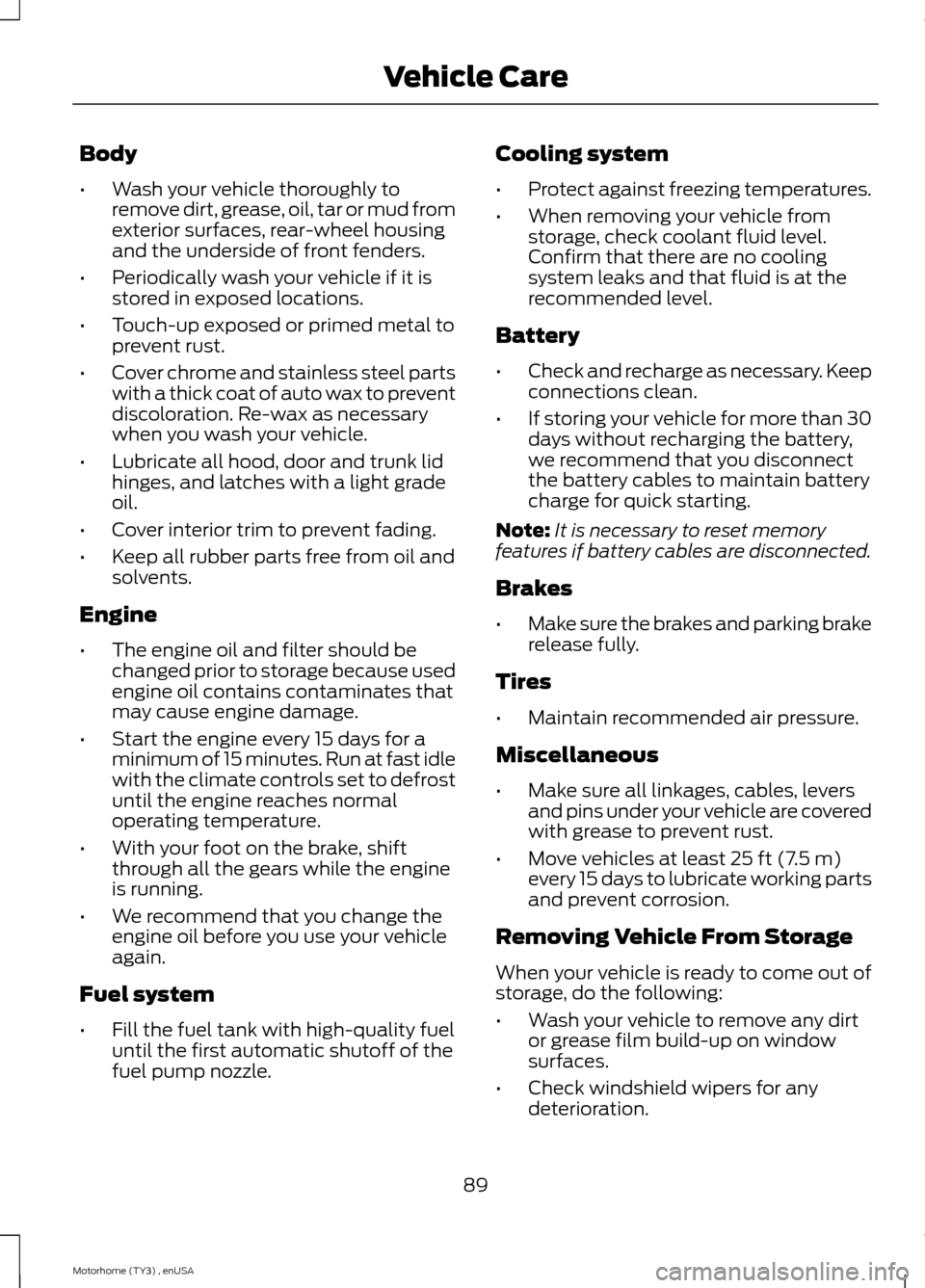
Body
•Wash your vehicle thoroughly toremove dirt, grease, oil, tar or mud fromexterior surfaces, rear-wheel housingand the underside of front fenders.
•Periodically wash your vehicle if it isstored in exposed locations.
•Touch-up exposed or primed metal toprevent rust.
•Cover chrome and stainless steel partswith a thick coat of auto wax to preventdiscoloration. Re-wax as necessarywhen you wash your vehicle.
•Lubricate all hood, door and trunk lidhinges, and latches with a light gradeoil.
•Cover interior trim to prevent fading.
•Keep all rubber parts free from oil andsolvents.
Engine
•The engine oil and filter should bechanged prior to storage because usedengine oil contains contaminates thatmay cause engine damage.
•Start the engine every 15 days for aminimum of 15 minutes. Run at fast idlewith the climate controls set to defrostuntil the engine reaches normaloperating temperature.
•With your foot on the brake, shiftthrough all the gears while the engineis running.
•We recommend that you change theengine oil before you use your vehicleagain.
Fuel system
•Fill the fuel tank with high-quality fueluntil the first automatic shutoff of thefuel pump nozzle.
Cooling system
•Protect against freezing temperatures.
•When removing your vehicle fromstorage, check coolant fluid level.Confirm that there are no coolingsystem leaks and that fluid is at therecommended level.
Battery
•Check and recharge as necessary. Keepconnections clean.
•If storing your vehicle for more than 30days without recharging the battery,we recommend that you disconnectthe battery cables to maintain batterycharge for quick starting.
Note:It is necessary to reset memoryfeatures if battery cables are disconnected.
Brakes
•Make sure the brakes and parking brakerelease fully.
Tires
•Maintain recommended air pressure.
Miscellaneous
•Make sure all linkages, cables, leversand pins under your vehicle are coveredwith grease to prevent rust.
•Move vehicles at least 25 ft (7.5 m)every 15 days to lubricate working partsand prevent corrosion.
Removing Vehicle From Storage
When your vehicle is ready to come out ofstorage, do the following:
•Wash your vehicle to remove any dirtor grease film build-up on windowsurfaces.
•Check windshield wipers for anydeterioration.
89Motorhome (TY3) , enUSAVehicle Care
Page 94 of 143
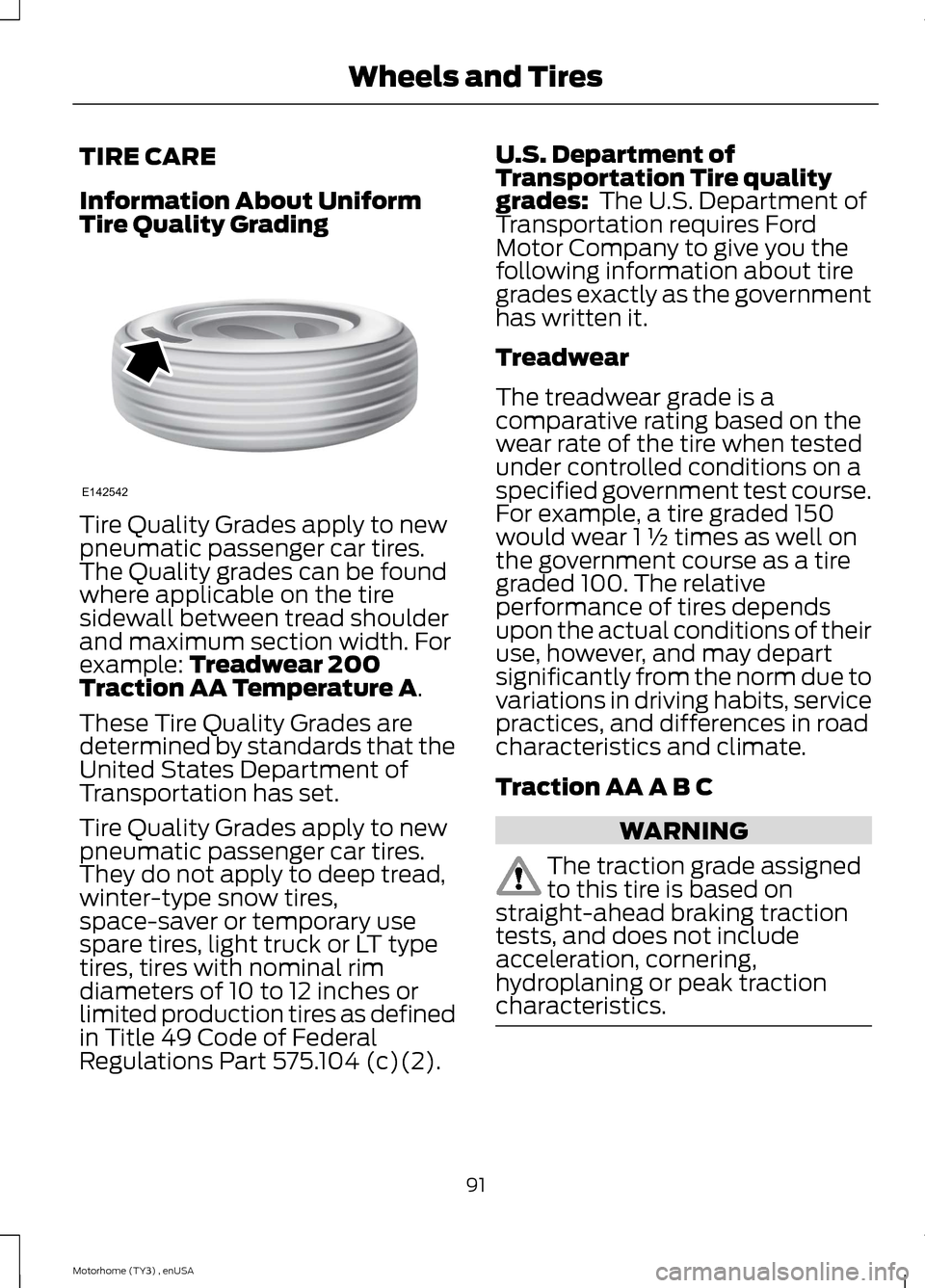
TIRE CARE
Information About UniformTire Quality Grading
Tire Quality Grades apply to newpneumatic passenger car tires.The Quality grades can be foundwhere applicable on the tiresidewall between tread shoulderand maximum section width. Forexample: Treadwear 200Traction AA Temperature A.
These Tire Quality Grades aredetermined by standards that theUnited States Department ofTransportation has set.
Tire Quality Grades apply to newpneumatic passenger car tires.They do not apply to deep tread,winter-type snow tires,space-saver or temporary usespare tires, light truck or LT typetires, tires with nominal rimdiameters of 10 to 12 inches orlimited production tires as definedin Title 49 Code of FederalRegulations Part 575.104 (c)(2).
U.S. Department ofTransportation Tire qualitygrades: The U.S. Department ofTransportation requires FordMotor Company to give you thefollowing information about tiregrades exactly as the governmenthas written it.
Treadwear
The treadwear grade is acomparative rating based on thewear rate of the tire when testedunder controlled conditions on aspecified government test course.For example, a tire graded 150would wear 1 ½ times as well onthe government course as a tiregraded 100. The relativeperformance of tires dependsupon the actual conditions of their
use, however, and may departsignificantly from the norm due tovariations in driving habits, servicepractices, and differences in roadcharacteristics and climate.
Traction AA A B C
WARNING
The traction grade assignedto this tire is based onstraight-ahead braking tractiontests, and does not includeacceleration, cornering,hydroplaning or peak tractioncharacteristics.
91Motorhome (TY3) , enUSAWheels and TiresE142542
Page 109 of 143
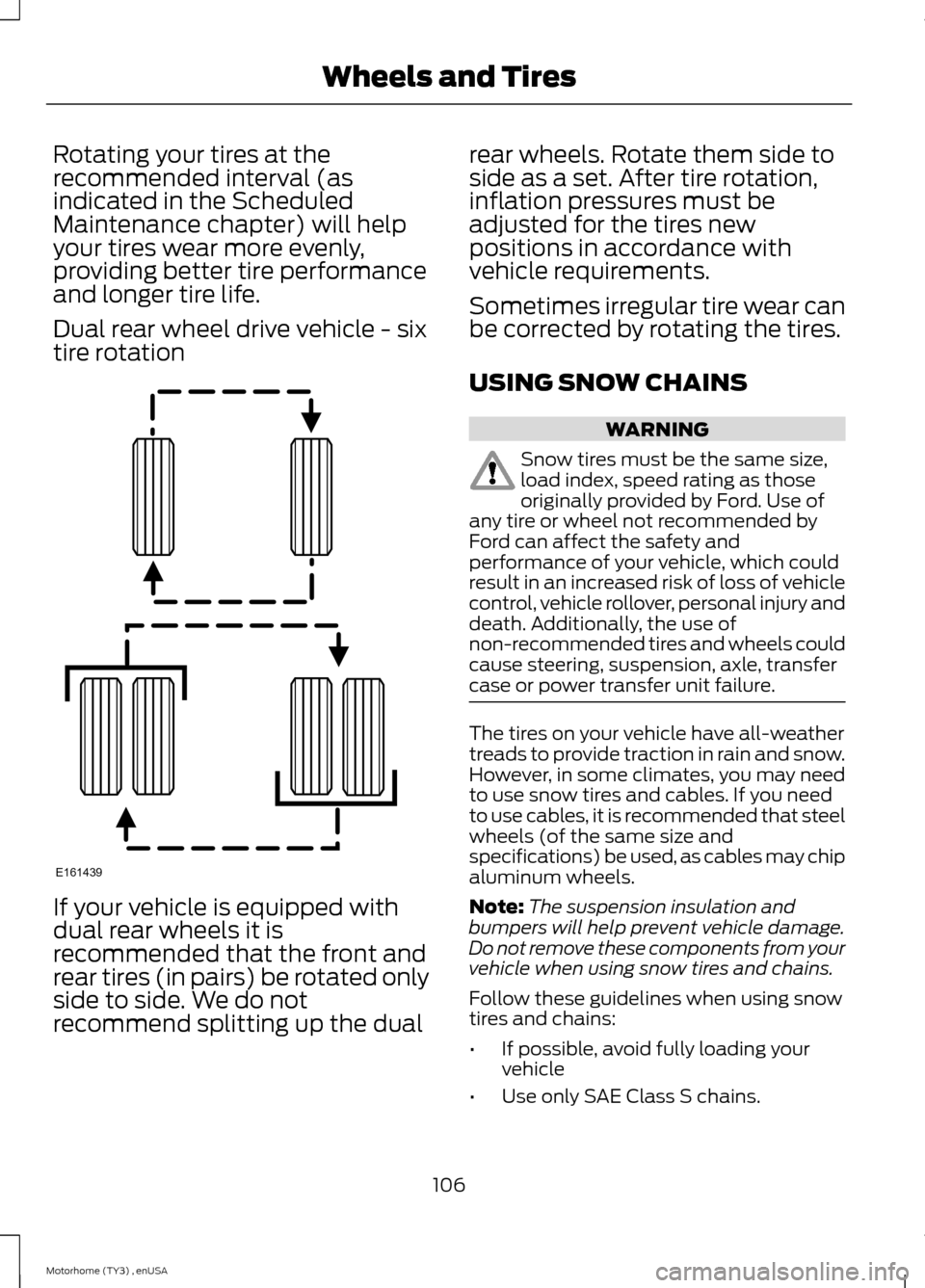
Rotating your tires at therecommended interval (asindicated in the ScheduledMaintenance chapter) will helpyour tires wear more evenly,providing better tire performanceand longer tire life.
Dual rear wheel drive vehicle - sixtire rotation
If your vehicle is equipped withdual rear wheels it isrecommended that the front andrear tires (in pairs) be rotated onlyside to side. We do notrecommend splitting up the dual
rear wheels. Rotate them side toside as a set. After tire rotation,inflation pressures must beadjusted for the tires newpositions in accordance withvehicle requirements.
Sometimes irregular tire wear canbe corrected by rotating the tires.
USING SNOW CHAINS
WARNING
Snow tires must be the same size,load index, speed rating as thoseoriginally provided by Ford. Use ofany tire or wheel not recommended byFord can affect the safety andperformance of your vehicle, which couldresult in an increased risk of loss of vehiclecontrol, vehicle rollover, personal injury anddeath. Additionally, the use ofnon-recommended tires and wheels couldcause steering, suspension, axle, transfercase or power transfer unit failure.
The tires on your vehicle have all-weathertreads to provide traction in rain and snow.However, in some climates, you may needto use snow tires and cables. If you needto use cables, it is recommended that steelwheels (of the same size andspecifications) be used, as cables may chipaluminum wheels.
Note:The suspension insulation andbumpers will help prevent vehicle damage.Do not remove these components from yourvehicle when using snow tires and chains.
Follow these guidelines when using snowtires and chains:
•If possible, avoid fully loading yourvehicle
•Use only SAE Class S chains.
106Motorhome (TY3) , enUSAWheels and TiresE161439
Page 140 of 143
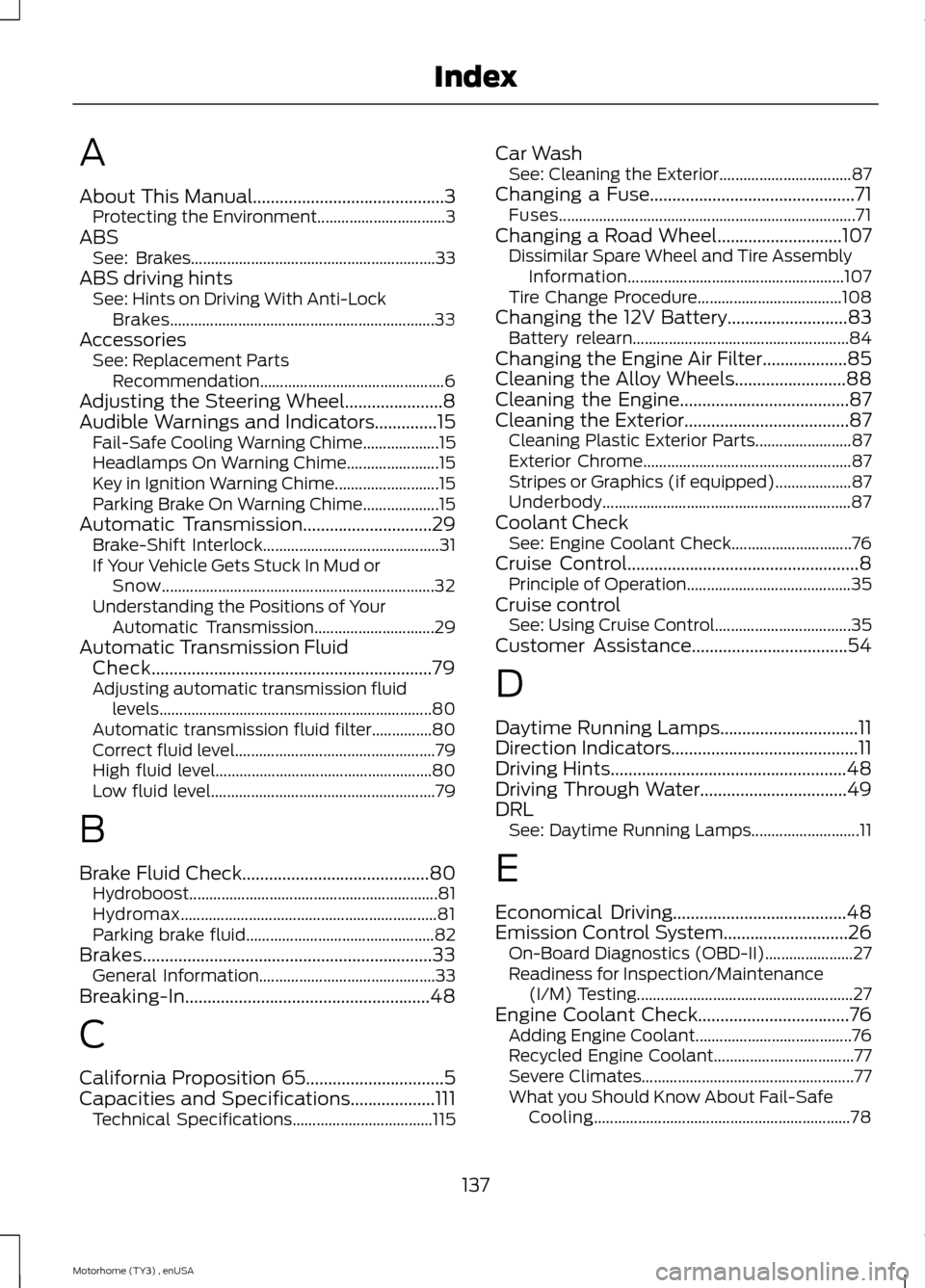
A
About This Manual...........................................3Protecting the Environment................................3ABSSee: Brakes.............................................................33ABS driving hintsSee: Hints on Driving With Anti-LockBrakes..................................................................33AccessoriesSee: Replacement PartsRecommendation..............................................6Adjusting the Steering Wheel......................8Audible Warnings and Indicators..............15Fail-Safe Cooling Warning Chime...................15Headlamps On Warning Chime.......................15Key in Ignition Warning Chime..........................15Parking Brake On Warning Chime...................15Automatic Transmission.............................29Brake-Shift Interlock............................................31If Your Vehicle Gets Stuck In Mud orSnow....................................................................32Understanding the Positions of YourAutomatic Transmission..............................29Automatic Transmission FluidCheck...............................................................79Adjusting automatic transmission fluidlevels....................................................................80Automatic transmission fluid filter...............80Correct fluid level..................................................79High fluid level......................................................80Low fluid level........................................................79
B
Brake Fluid Check..........................................80Hydroboost..............................................................81Hydromax................................................................81Parking brake fluid...............................................82Brakes.................................................................33General Information............................................33Breaking-In.......................................................48
C
California Proposition 65...............................5Capacities and Specifications...................111Technical Specifications...................................115
Car WashSee: Cleaning the Exterior.................................87Changing a Fuse..............................................71Fuses..........................................................................71Changing a Road Wheel............................107Dissimilar Spare Wheel and Tire AssemblyInformation......................................................107Tire Change Procedure....................................108Changing the 12V Battery...........................83Battery relearn......................................................84Changing the Engine Air Filter...................85Cleaning the Alloy Wheels.........................88Cleaning the Engine......................................87Cleaning the Exterior.....................................87Cleaning Plastic Exterior Parts........................87Exterior Chrome....................................................87Stripes or Graphics (if equipped)...................87Underbody..............................................................87Coolant CheckSee: Engine Coolant Check..............................76Cruise Control....................................................8Principle of Operation.........................................35Cruise controlSee: Using Cruise Control..................................35Customer Assistance...................................54
D
Daytime Running Lamps...............................11Direction Indicators..........................................11Driving Hints.....................................................48Driving Through Water.................................49DRLSee: Daytime Running Lamps...........................11
E
Economical Driving.......................................48Emission Control System............................26On-Board Diagnostics (OBD-II)......................27Readiness for Inspection/Maintenance(I/M) Testing......................................................27Engine Coolant Check..................................76Adding Engine Coolant.......................................76Recycled Engine Coolant...................................77Severe Climates.....................................................77What you Should Know About Fail-SafeCooling................................................................78
137Motorhome (TY3) , enUSAIndex